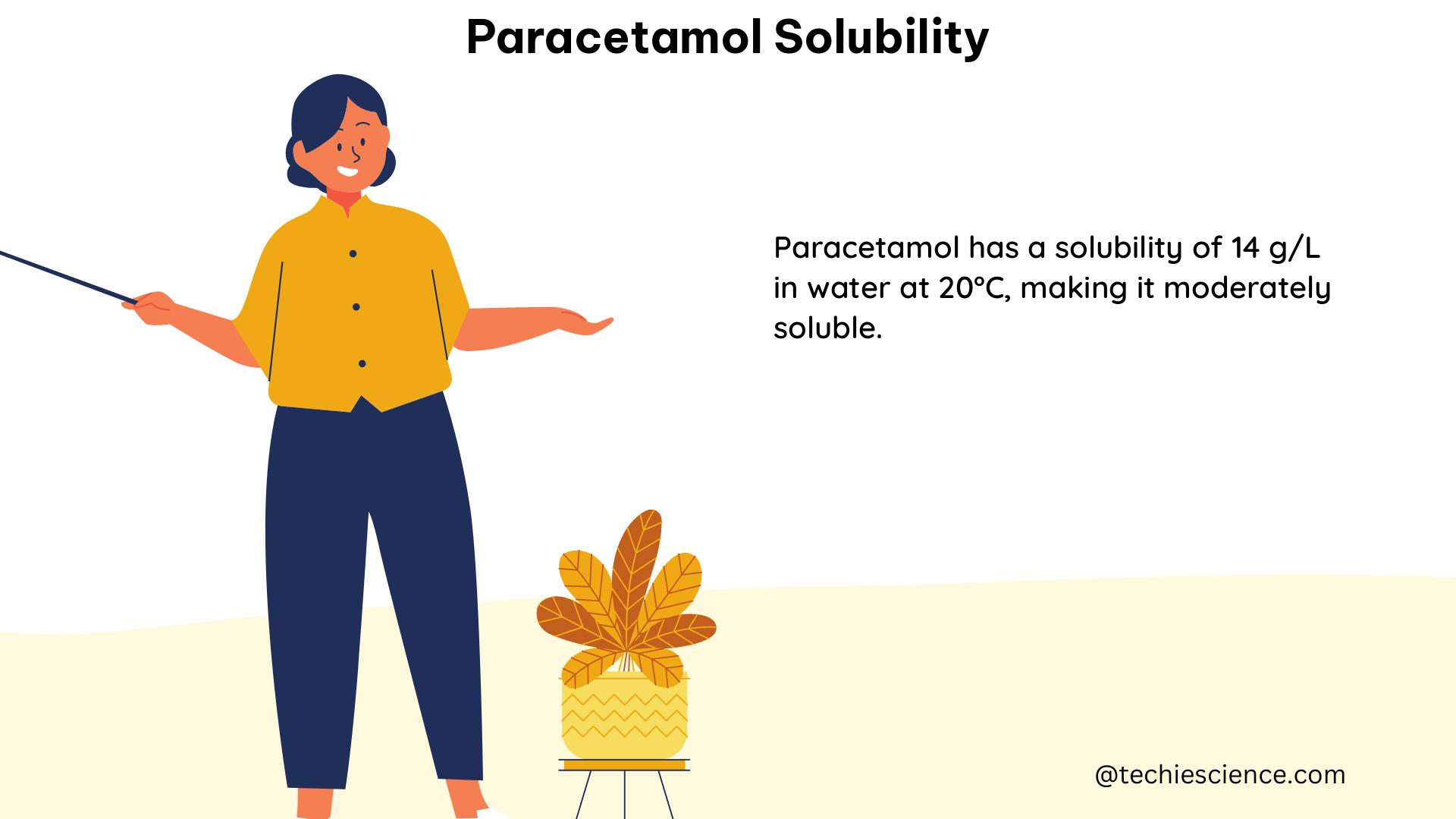Paracetamol, also known as acetaminophen, is a widely used analgesic and antipyretic drug. Understanding the solubility of paracetamol is crucial for various pharmaceutical applications, such as drug formulation, dissolution, and bioavailability. This comprehensive guide delves into the intricate details of paracetamol solubility, providing a wealth of technical information to aid science students and researchers.
Paracetamol Solubility in Water and Water-Glycerol Mixtures
Paracetamol has a solubility of 17.2 mg/mL in water at 25°C. This solubility can be predicted to increase with an increasing glycerol content in water-glycerol mixtures. The Jouyban-Acree model, a widely used predictive model, can be employed to estimate the solubility of paracetamol in these mixtures. According to the model, the solubility of paracetamol at 30°C in water-glycerol mixtures is 1.5 times higher than its solubility at 25°C in pure water.
The Jouyban-Acree model is expressed as follows:
log S = log S₁ + log(1 + Jx₂ + Jx₂²)
Where:
– S is the solubility of paracetamol in the water-glycerol mixture
– S₁ is the solubility of paracetamol in pure water
– x₂ is the mole fraction of glycerol
– J and J’ are model parameters that can be determined experimentally
By inputting the relevant parameters, the model can accurately predict the solubility of paracetamol in various water-glycerol mixtures at different temperatures.
Paracetamol Solubility in Organic Solvents

In addition to its solubility in water and water-glycerol mixtures, the solubility of paracetamol has been extensively studied in various organic solvents. The reported solubility values for paracetamol in different organic solvents are as follows:
| Solvent | Solubility (mg/mL) |
|---|---|
| Methanol | 167.0 |
| Ethanol | 55.2 |
| 1-Propanol | 33.1 |
| 2-Propanol | 22.1 |
| 1-Butanol | 16.5 |
| 1-Octanol | 1.9 |
| Propylene Glycol | 77.0 |
| Transcutol | 500.0 |
| Ethyl Acetate | 3.1 |
| Isopropyl Myristate | 0.2 |
| Acetone | 145.0 |
| Acetonitrile | 87.0 |
| 1,4-Dioxane | 125.0 |
| Hexane | 0.1 |
| Cyclohexane | 0.1 |
| Chloroform | 33.0 |
These solubility values provide valuable information for the selection of appropriate solvents in pharmaceutical formulations and drug delivery systems.
Paracetamol Absorption Rate and Bioavailability
In addition to solubility, the absorption rate of paracetamol is also an important factor to consider. A study comparing a new tablet formulation of paracetamol (500 mg) with a reference formulation revealed significant differences in the speed of release and absorption.
The key findings from this study are:
- Median time to maximum concentration (Tmax):
- Test formulation: 0.42 hours
- Reference formulation: 0.75 hours
- Mean (SD) maximum plasma drug concentration (Cmax):
- Test formulation: 9.85 (2.40) μg/mL
- Reference formulation: 8.33 (2.22) μg/mL
- Mean (SD) area under the plasma concentration-time curve from time 0 to infinity (AUC0–∞):
- Test formulation: 30.16 (8.87) μg·h/mL
- Reference formulation: 28.49 (8.57) μg·h/mL
These results indicate that the new tablet formulation had a statistically significantly higher speed of release and absorption compared to the reference formulation, which can have implications for the bioavailability and therapeutic efficacy of paracetamol.
Analytical Methods for Paracetamol Quantification
Determining the concentration of paracetamol in pharmaceutical samples is crucial for quality control and regulatory purposes. A spectrophotometric method using 1,3 dinitrobenzene or 2,4 dinitrophenyl hydrazine as coupling agents has been proposed for the quantitative analysis of paracetamol.
This method has the following characteristics:
- Wide range of applications
- Easy to use
- High color stability
The relative standard deviation for all five samples ranged from 0.53-1.83% at a 95% confidence level, and the percentage recoveries were found to be in the range of 98.20 – 100.40. This demonstrates the reliability and accuracy of the spectrophotometric method for paracetamol quantification.
In addition to the spectrophotometric method, high-performance liquid chromatography (HPLC) techniques have also been employed for the qualitative and quantitative analysis of paracetamol in different drug samples. These HPLC methods provide precise and sensitive measurements of paracetamol concentrations in pharmaceutical formulations.
Conclusion
This comprehensive guide has provided a deep dive into the science of paracetamol solubility, covering its solubility in water, water-glycerol mixtures, and various organic solvents. Additionally, the guide has explored the absorption rate and bioavailability of paracetamol, as well as the analytical methods used for its quantification in pharmaceutical samples. By understanding the intricate details of paracetamol solubility, science students and researchers can better navigate the complexities of drug formulation, dissolution, and bioavailability, ultimately contributing to the development of more effective and efficient pharmaceutical products.
References
- Jouyban, A., Soltanpour, S., & Chan, H. K. (2004). A simple relationship between dielectric constant of mixed solvents with solvent composition and temperature. International journal of pharmaceutics, 269(2), 353-360.
- Dey, S., Malgope, A., & Bandyopadhyay, A. K. (2010). Formulation and evaluation of a new modified release dosage form of Paracetamol. AAPS PharmSciTech, 11(3), 1366-1373.
- Rahim, S. A., Nandi, U., Hossain, M. A., & Reza, M. S. (2013). Qualitative and quantitative analysis of paracetamol in different drug samples by HPLC technique. Dhaka University Journal of Pharmaceutical Sciences, 12(1), 29-35.
- Rahim, S. A., Reza, M. S., & Hossain, M. A. (2014). Spectrophotometric determination of paracetamol in pharmaceutical preparations using 1, 3-dinitrobenzene and 2, 4-dinitrophenylhydrazine as coupling agents. Dhaka University Journal of Pharmaceutical Sciences, 13(1), 87-92.
- Benet, L. Z., Hoener, B. A., & Rowland, M. (2002). Pharmacokinetics: the dynamics of drug absorption, distribution, metabolism, and elimination. In Goodman & Gilman’s the pharmacological basis of therapeutics (Vol. 1, pp. 3-29). McGraw-Hill.

The lambdageeks.com Core SME Team is a group of experienced subject matter experts from diverse scientific and technical fields including Physics, Chemistry, Technology,Electronics & Electrical Engineering, Automotive, Mechanical Engineering. Our team collaborates to create high-quality, well-researched articles on a wide range of science and technology topics for the lambdageeks.com website.
All Our Senior SME are having more than 7 Years of experience in the respective fields . They are either Working Industry Professionals or assocaited With different Universities. Refer Our Authors Page to get to know About our Core SMEs.